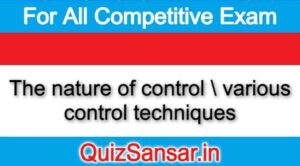
The nature of control various control techniques
Nature of Controlling
The main characteristics of controlling are as follows:
1. Management Function: Controlling is a function of management. In fact, it is a follow-up action to other functions of management. Management process cannot be complete without control.
2. Pervasive Function: Controlling is an essential function of every manager. All managers perform the control function. Control is exercised at all levels of management though the nature and extent of control may differ from one level to another. Controlling is an universal
3. Continuous Process: Controlling is a continuous or never ending process. According to Koontz and O’ Donnell, “Just as the navigator continually takes a planned action, so should the business manager continually take to controlling to assure himself that his enterprise or department is on course.”
Various Control Techniques
The various control techniques are discussed below:
(1) Traditional Methods
1. Direct Supervision and Observation: ‘Direct Supervision and Observation’ is the oldest technique of controlling. The supervisor himself observes the employees and their work. This brings him in direct contact with the workers. So, many problems are solved during supervision. The supervisor gets first hand information, and he has better understanding with the workers. This technique is most suitable for a small-sized business.
2. Financial Statements: All business organisations prepare Profit and Loss Account. It gives a summary of the income and expenses for a specified period. They also prepare Balance Sheet, which shows the financial position of the organisation at the end of the specified period. Financial statements are used to control the organisation. The figures of the current year can be compared with the previous year’s figures. They can also be compared with the figures of other similar organisations.
Ratio analysis can be used to find out and analyze the financial statements. Ratio analysis helps to understand the profitability, liquidity and solvency position of the business.
3. Budgetary Control: A budget is a planning and controlling device. Budgetary control is a technique of managerial control through budgets. It is the essence of financial control. Budgetary control is done for all aspects of a business such as income, expenditure, production, capital and revenue. Budgetary control is done by the budget committee.
4. Break Even Analysis: Break Even Analysis or Break Even Point is the point of no profit, no loss. For e.g. When an organisation sells 50K cars it will break even. It means that, any sale below this point will cause losses and any sale above this point will earn profits.
The Break-even analysis acts as a control device. It helps to find out the company’s performance. So the company can take collective action to improve its performance in the future. Break-even analysis is a simple control tool.
5. Return on Investment (ROI): Investment consists of fixed assets and working capital used in business. Profit on the investment is a reward for risk taking. If the ROI is high then the financial performance of a business is good and vice-versa.
ROI is a tool to improve financial performance. It helps the business to compare its present performance with that of previous years’ performance. It helps to conduct inter-firm comparisons. It also shows the areas where corrective actions are needed.
(II) Modern Methods
6. Management by Objectives (MBO): MBO facilitates planning and control. It must fulfill following requirements: (i) Objectives for individuals are jointly fixed by the superior and the subordinate. (ii) Periodic evaluation and regular feedback to evaluate individual performance. (iii) Achievement of objectives brings rewards to individuals.
7. Management Audit: Management Audit is an evaluation of the management as a whole. It critically examines the full management process, i.e. planning, organising, directing, and controlling. It finds out the efficiency of the management. To check the efficiency of the management, the company’s plans, objectives, policies, procedures, personnel relations and systems of control are examined very carefully. Management auditing is conducted by a team of experts. They collect data from past records, members of management, clients and employees. The data is analysed and conclusions are drawn about managerial performance and efficiency.
8. Management Information System (MIS): In order to control the organisation properly the management needs accurate information. They need information about the internal working of the organisation and also about the external environment. Information is collected continuously to identify problems and find out solutions. MIS collects data, processes it and provides it to the managers. MIS may be manual or computerised. With MIS, managers can delegate authority to subordinates without losing control.
9. PERT and CPM Techniques: Programme Evaluation and Review Technique (PERT) and Critical Path Method (CPM) techniques were developed in USA in the late 50’s. Any programme consists of various activities and sub-activities. Successful completion of any activity depends upon doing the work in a given sequence and in a given time.
CPM/PERT can be used to minimise the total time or the total cost required to perform the total operations.
Importance is given to identifying the critical activities. Critical activities are those which have to be completed on time otherwise the full project will be delayed. So, in these techniques, the job is divided into various activities/ sub-activities. From these activities, the critical activities are identified.
More importance is given to completion of these critical activities. So. by controlling the time of the critical activities, the total time and cost of the job are minimised.
10. Self-Control: Self-Control means self-directed control. A person is given freedom to set his own targets, evaluate his own performance and take corrective measures as and when required. Self control is especially required for top level managers because they do not like external control.
The subordinates must be encouraged to use self-control because it is not good for the superior to control each and everything. However, self-control does not mean no control by the superiors. The superiors must control the important activities of the subordinates.






